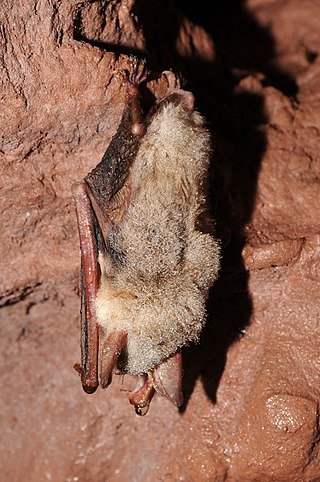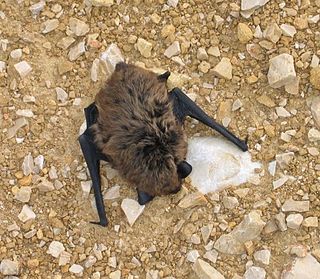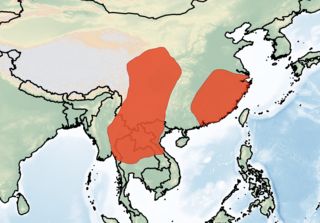
Vespertilionidae is a family of microbats, of the order Chiroptera, flying, insect-eating mammals variously described as the common, vesper, or simple nosed bats. The vespertilionid family is the most diverse and widely distributed of bat families, specialised in many forms to occupy a range of habitats and ecological circumstances, and it is frequently observed or the subject of research. The facial features of the species are often simple, as they mainly rely on vocally emitted echolocation. The tails of the species are enclosed by the lower flight membranes between the legs. Over 300 species are distributed all over the world, on every continent except Antarctica. It owes its name to the genus Vespertilio, which takes its name from a word for bat, vespertilio, derived from the Latin term vesper meaning 'evening'; they are termed "evening bats" and were once referred to as "evening birds".

Savi's pipistrelle is a species of vesper bat found across North West Africa, the Mediterranean region and the Middle East. It feeds at night on flying insects. In the summer it roosts under bark, in holes in trees, in old buildings and in rock crevices but in winter it prefers roosts where the temperature is more even such as caves, underground vaults and deep rock cracks.

The chocolate pipistrelle is a species of vesper bat in the family Vespertilionidae. It is found in China, India, Myanmar, Nepal, and Sri Lanka.

The pungent pipistrelle is a species of vesper bat in the family Vespertilionidae. It is found in Indonesia and possibly the Philippines.

The Peters's pipistrelle is a species of vesper bat in the family Vespertilionidae. It is found in Indonesia, Malaysia, and the Philippines.

Cadorna's pipistrelle is a species of vesper bat in the family Vespertilionidae. It is found in India, Laos, Myanmar, Thailand, and Vietnam.

The Burma pipistrelle is a species of vesper bat in the family Vespertilionidae found in Myanmar. It is known only from Maliwun in Tanintharyi Region.

The big-eared pipistrelle is a species of vesper bat in the family Vespertilionidae. It can be found in Indonesia and Malaysia. It forages over mud flats over Peninsula Malaysia but its roosting activities are unknown. Its habitat is being threatened by deforestation for agriculture, plantations, logging and fires but how it affects this bat or if it is adaptable are unknown.

The Chinese pipistrelle is a species of vesper bat in the family Vespertilionidae. It is found in China, Laos, Thailand, and Vietnam.

The Burmese whiskered myotis or Burmese whiskered bat is a species of vesper bat. It is found in China, India, Myanmar, Laos, and Vietnam.
Falsistrellus is a genus of vespertilionid family of bats, small predatory flying mammals. They are known from Australia. The poorly researched species have been variously placed by authors, and revised again by studies of their distinct characteristics, consequently the falsistrelles may also be referred to as pipistrelles or false pipstrelles.

The genus Hypsugo contains many bats referred to as pipistrelles or pipistrelle bats. They belong to the family Vespertilionidae or vesper bats. They are primarily found throughout Asia, the Middle East, Mediterranean Europe, and North Africa, with a single (debated) species in Sub-Saharan Africa.

The long-toothed pipistrelle is a species of bat of the genus Hypsugo. It is a small bat, with a length of 35.2–38.4 mm of forearm, and 5.9–7 mm of foot. It feeds on insects and has especially long canines compared to others of its genus.
The Kirindy serotine is a species of vesper bat in the family Vespertilionidae. It occurs in the central and south-central portions of western Madagascar. As of the most recent IUCN assessment in May 2016, it is of least concern.

Myotis indochinensis, commonly known as the Indochinese mouse-eared bat, is a species of cave-dwelling bat in the family Vespertilionidae. It is found in Vietnam and China.

Glischropus bucephalus, the Indochinese thick-thumbed bat, is a species of bat in the family Vespertilionidae. The bat is found in Cambodia, Myanmar, Laos, Thailand and Vietnam north of the Isthmus of Kra.
Weber's myotis is a species of vesper bat endemic to the Indonesian island of Sulawesi.

Peyton's myotis, also known as Peyton's whiskered bat, is a species of vesper bat endemic to India.

The Malaysian whiskered myotis or Malayan whiskered myotis is a species of vesper bat endemic to Malaysia, although it may possibly also occur in Indonesia.

The Bornean whiskered myotis is a species of vesper bat endemic to Borneo.
















